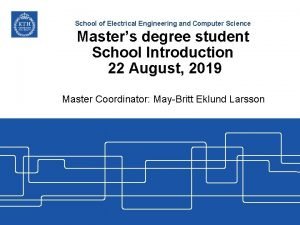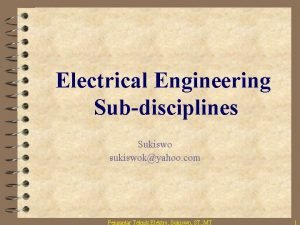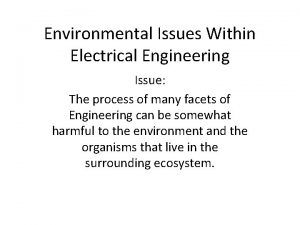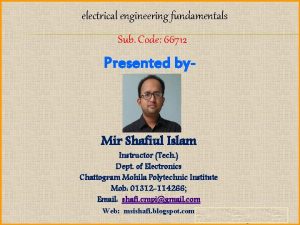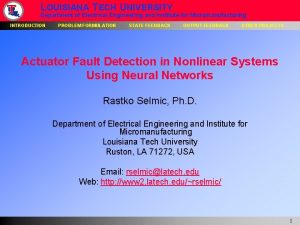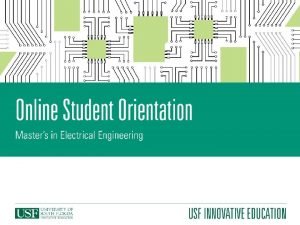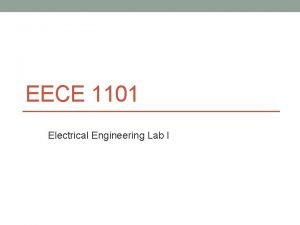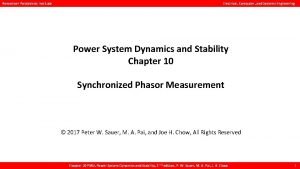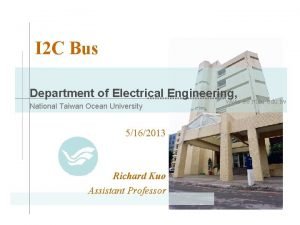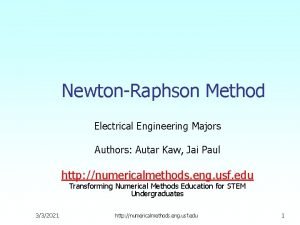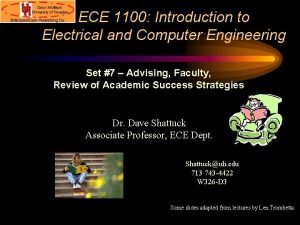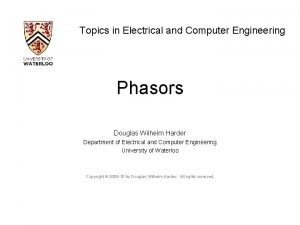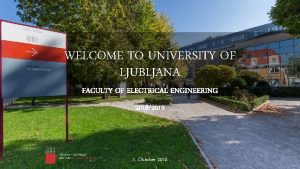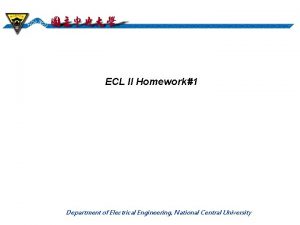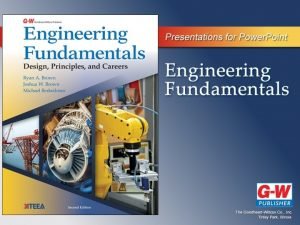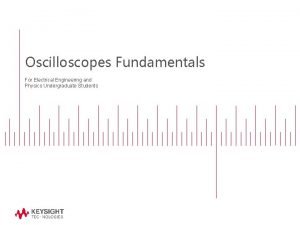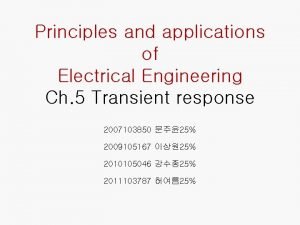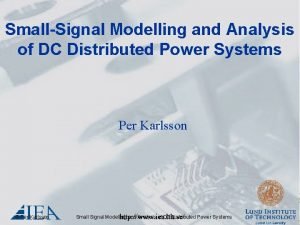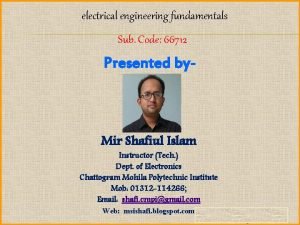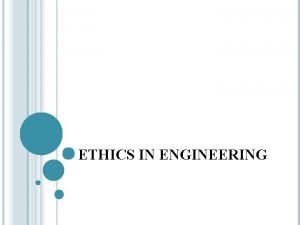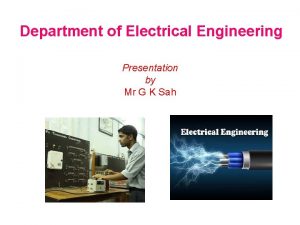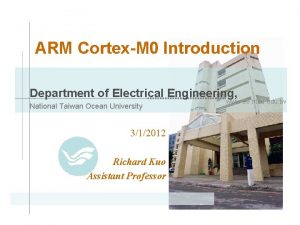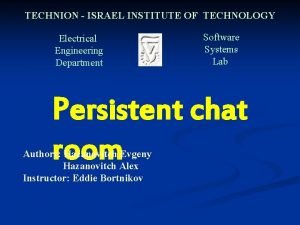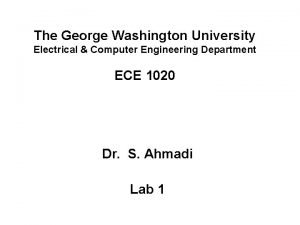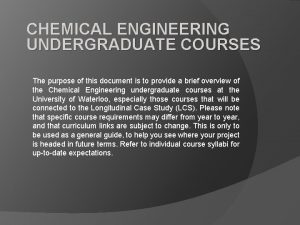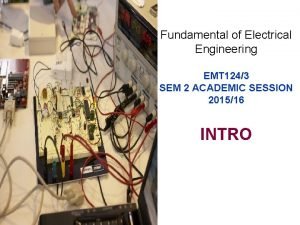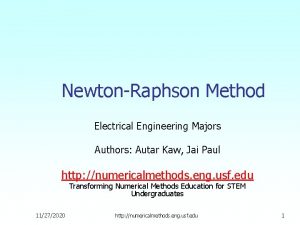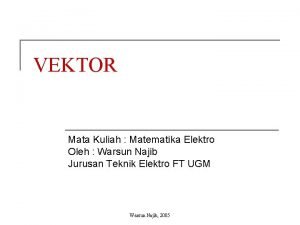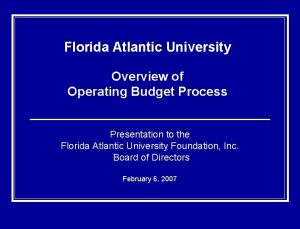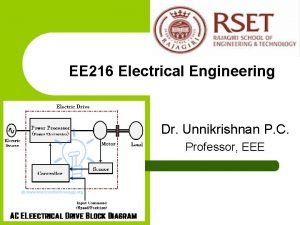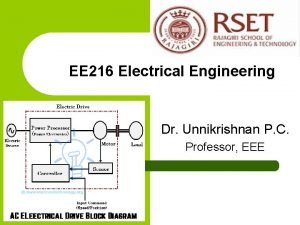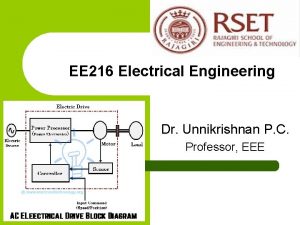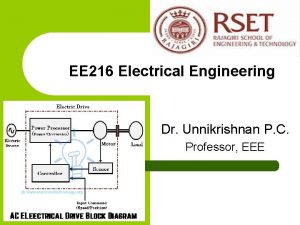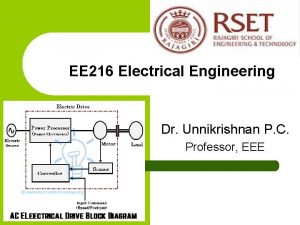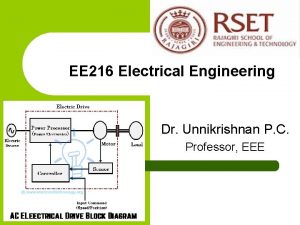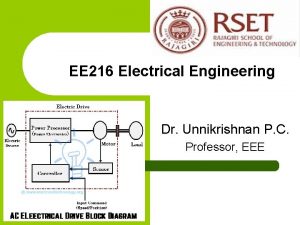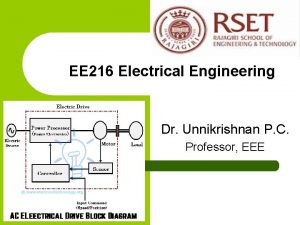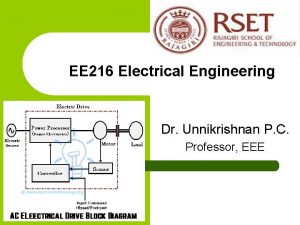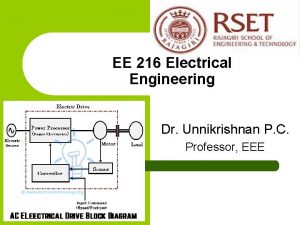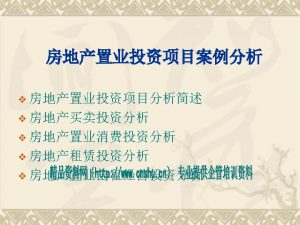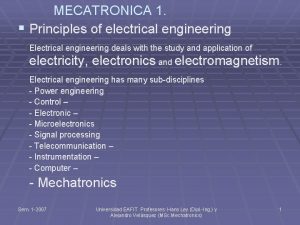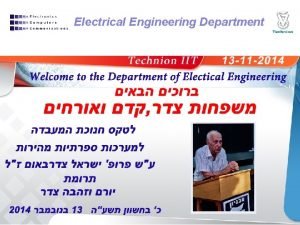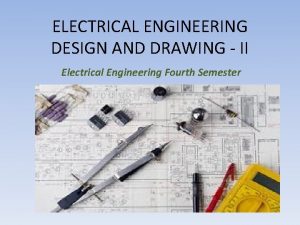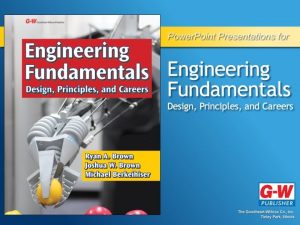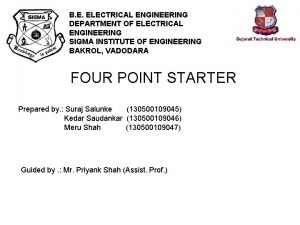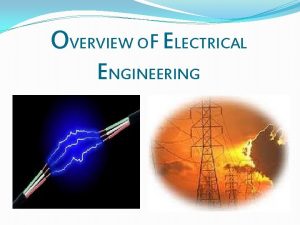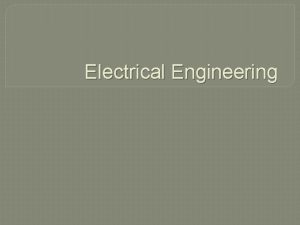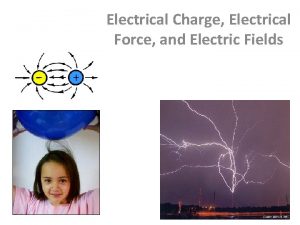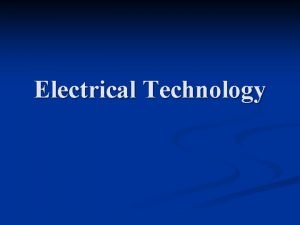EE 216 Electrical Engineering Dr Unnikrishnan P C





















































- Slides: 53

EE 216 Electrical Engineering Dr. Unnikrishnan P. C. Professor, EEE

Induction Motor Advantages • • • Robust; No brushes. No contacts on rotor shaft High Power/Weight ratio compared to DC motor Lower Cost/Power Easy to manufacture Almost maintenance-free, except for bearing and other mechanical parts • wide range of power ratings: fractional HP to 10 MW

Induction Motor Disadvantages • Essentially a “fixed-speed” machine • Speed is determined by the supply frequency • To vary its speed need a variable frequency supply

Parts of an Induction Motor

Construction • An induction motor has two main parts – a stationary stator • consisting of a steel frame that supports a hollow, cylindrical core • core, constructed from stacked laminations (why? ), having a number of evenly spaced slots, providing the space for the stator winding

Construction- Stator

Construction-Rotor • Two basic designs – Squirrel-Cage: conducting copper or aluminium bars laid into slots and shorted at both ends by shorting rings. (Squirrel Cage Induction Motor) – Wound-Rotor: complete set of three-phase windings exactly as the stator. Usually Yconnected, the ends of the three rotor wires are connected to 3 slip rings on the rotor shaft. In this way, the rotor circuit is accessible. (Slip-Ring Induction Motor)

Construction Squirrel cage rotor Wound rotor Notice the slip rings

Construction- Rotor (Squirrel Cage)

Construction-Wound Rotor (Slip Ring Induction Motor) Slip rings Cutaway in a typical woundrotor IM. Notice the brushes and the slip rings Brushes

Rotating Magnetic Field • Balanced three phase windings, i. e. mechanically displaced 120 degrees form each other, fed by balanced three phase source • A rotating magnetic field with constant magnitude is produced, rotating with a speed Where fe is the supply frequency and P is the no. of poles and nsync is called the synchronous speed in rpm

Synchronous speed P 50 Hz 60 Hz 2 3000 3600 4 1500 1800 6 1000 1200 8 750 900 10 600 720 12 500 600

Rotating Magnetic Field

Rotating Magnetic Field

Principle of operation •

Induction Motor Speed • At what speed will the IM run? – Can the IM run at the synchronous speed, why? – If rotor runs at the synchronous speed, which is the same speed of the rotating magnetic field, then the rotor will appear stationary to the rotating magnetic field and the rotating magnetic field will not cut the rotor. So, no induced current will flow in the rotor and no rotor magnetic flux will be produced so no torque is generated and the rotor speed will fall below the synchronous speed – When the speed falls, the rotating magnetic field will cut the rotor windings and a torque is produced

Induction Motor Speed •

The Slip Notice that : if the rotor runs at synchronous speed s = 0 if the rotor is stationary s = 1 Slip may be expressed as a percentage by multiplying the above eq. by 100, notice that the slip is a ratio and doesn’t have units

Frequency •

Equivalent Circuit of an IM Ee can utilise the equivalent circuit of a transformer to model an induction motor. R 1 - Resistance of the stator winding X 1 Stator leakage reactance Xm - Magnetising reactance required to cross the air gap Rc - Core losses

Equivalent Circuit of an IM- Modified

R 1 = Stator resistance per phase. X 1 = Stator reactance per phase V 1 = Stator voltage per phase has to counter balance self induced e. m. f. E 1 and has to supply voltage drops I 1 R 1 and I 1 X 1. The rotor induced e. m. f. in the running condition has to supply the drop across impedances as rotor short circuited.

Phasor Diagram of an Induction Motor

Starters- Squirrel Cage IM • • Direct-On-line Starting Stator Rheostat Starting Autotransformer Starting Star-Delta Starter

Direct On-Line(DOL) Starter • Used for motors upto 2 k. W • Starting torque about twice the full load torque

Stator Rheostat Starter Advantages: High PF during start, Less Expensive, Smooth acceleration Disadvantages: Losses in Resistors, Expensive, Low torque efficiency

Auto-Transformer Starter Advantages: High torque/Ampere, Long starting period, Can be used for star and delta connected motors, Disadvantages: Low PF (Lagging), Higher cost

Star-Delta Starter • Reduced starting current but the starting torque is also reduced by the same amount • Limited to applications where high starting torque is not necessary

Starters- Slip Ring IM • Rotor Rheostat • Autotransformer Starting • Star-Delta Starter

Rotor Rheostat Starter for Slip Ring IM • By increasing rotor resistance, the rotor current is reduced at starting. The torque is increased due to improvement in PF • Such motors can be started under load

Torque •

Horse Power •

Torque-Slip Equation

Torque-Slip Characteristics

Power losses in Induction Machines • Copper losses – Copper loss in the stator (PSCL) = I 12 R 1 – Copper loss in the rotor (PRCL) = I 22 R 2 • Core loss (Pcore) • Mechanical power loss due to friction and windage • How this power flow in the motor?

Power Flow in Induction Motor

Power Relations

Torque-speed characteristics Typical torque-speed characteristics of induction motor

Maximum torque Effect of rotor resistance on torque-speed characteristic

Speed Control Methods of IM •

Constant V/F Control Of Induction Motor • If the supply frequency is reduced keeping the rated supply voltage, the air gap flux will tend to saturate causing excessive stator current and distortion of the stator flux wave. • If the ratio of voltage to frequency is kept constant, the flux remains constant. Also, the developed torque remains approximately constant.

Speed Control Methods Of IM …. . Induction Motor Speed Control From Rotor Side • Rotor Rheostat Control • Cascade Operation • By Injecting EMF In Rotor Circuit: By changing the phase of injected emf, speed can be controlled

Cascade Operation

Example A 208 -V, 10 hp, four pole, 60 Hz, Y-connected induction motor has a full-load slip of 5 percent 1. What is the synchronous speed of this motor? 2. What is the rotor speed of this motor at rated load? 3. What is the rotor frequency of this motor at rated load? 4. What is the shaft torque of this motor at rated load?

Solution 1. 2. 3. 4.

Example A 480 -V, 60 Hz, 50 -hp, three phase induction motor is drawing 60 A at 0. 85 PF lagging. The stator copper losses are 2 k. W, and the rotor copper losses are 700 W. The friction and windage losses are 600 W, the core losses are 1800 W, and the stray losses are negligible. Find the following quantities: 1. 2. 3. 4. The air-gap power PAG. The power converted Pconv. The output power Pout. The efficiency of the motor.

Solution 1. 2. 3.

Solution 4.

Example A two-pole, 50 -Hz induction motor supplies 15 k. W to a load at a speed of 2950 rpm. 1. What is the motor’s slip? 2. What is the induced torque in the motor in N. m under these conditions? 3. What will be the operating speed of the motor if its torque is doubled? 4. How much power will be supplied by the motor when the torque is doubled?

Solution 1. 2.

Solution 3. In the low-slip region, the torque-speed curve is linear and the induced torque is direct proportional to slip. So, if the torque is doubled the new slip will be 3. 33% and the motor speed will be 4.

Question? • Q: How to change the direction of rotation? • A: Change the phase sequence of the power supply.

Question? • Q: Why rotor core loss in a three phase induction motor negligible? • A: Usually we operate motor at slip in the range 0. 04 ~ 0. 06, thus for a stator frequency of 50 Hz , rotor frequency is around 2~3 Hz. As core losses are proportional to square of frequency (Eddy current losses) or proportional to frequency ( Hysteresis losses) , therefore the value of the Core loss is negligible for rotor.
 Lina lehn
Lina lehn Klipsch school of electrical and computer engineering
Klipsch school of electrical and computer engineering Electrical engineering notation
Electrical engineering notation Deguration
Deguration Electrical engineering
Electrical engineering Principles and applications of electrical engineering
Principles and applications of electrical engineering Electrical engineering has many subdisciplines
Electrical engineering has many subdisciplines Electrical engineering environmental issues
Electrical engineering environmental issues Ohm's law
Ohm's law Louisiana tech electrical engineering
Louisiana tech electrical engineering George washington university electrical engineering
George washington university electrical engineering Usf canvas
Usf canvas Principles and applications of electrical engineering
Principles and applications of electrical engineering Electrical engineering
Electrical engineering Big data in electrical engineering
Big data in electrical engineering Tum department of electrical and computer engineering
Tum department of electrical and computer engineering Rensselaer polytechnic institute electrical engineering
Rensselaer polytechnic institute electrical engineering Electrical engineering department
Electrical engineering department Ntou ee
Ntou ee Newton raphson method electrical engineering
Newton raphson method electrical engineering Electrical engineering
Electrical engineering Wpi ece 2010
Wpi ece 2010 Uh electrical engineering flowchart
Uh electrical engineering flowchart Igor dujlovic
Igor dujlovic Tel aviv university electrical engineering
Tel aviv university electrical engineering Phasors in electrical engineering
Phasors in electrical engineering E.fe spletna učilnica
E.fe spletna učilnica Ucla electrical engineering
Ucla electrical engineering Electrical engineering
Electrical engineering Define electrical engineering
Define electrical engineering Electrical engineering
Electrical engineering Principle and application of electrical engineering
Principle and application of electrical engineering Umd electrical engineering
Umd electrical engineering Hello im human
Hello im human Electrical engineering
Electrical engineering Electrical engineering fundamentals 66712 pdf
Electrical engineering fundamentals 66712 pdf Larom case
Larom case Electrical engineering presentation
Electrical engineering presentation Electrical engineering roadmap
Electrical engineering roadmap Electrical engineering technion
Electrical engineering technion Northwestern computer science department
Northwestern computer science department University of belgrade school of electrical engineering
University of belgrade school of electrical engineering George washington university electrical engineering
George washington university electrical engineering Asu abet accreditation
Asu abet accreditation Electrical engineering math
Electrical engineering math Fundamental of electrical engineering
Fundamental of electrical engineering Analogy between electric and magnetic circuits
Analogy between electric and magnetic circuits Newton raphson method electrical engineering
Newton raphson method electrical engineering What is estimation in electrical engineering
What is estimation in electrical engineering Clemson university electrical engineering faculty
Clemson university electrical engineering faculty Vector electrical engineering
Vector electrical engineering Fau computer engineering flowchart
Fau computer engineering flowchart Electrical engineering
Electrical engineering Electrical engineering kfupm
Electrical engineering kfupm
